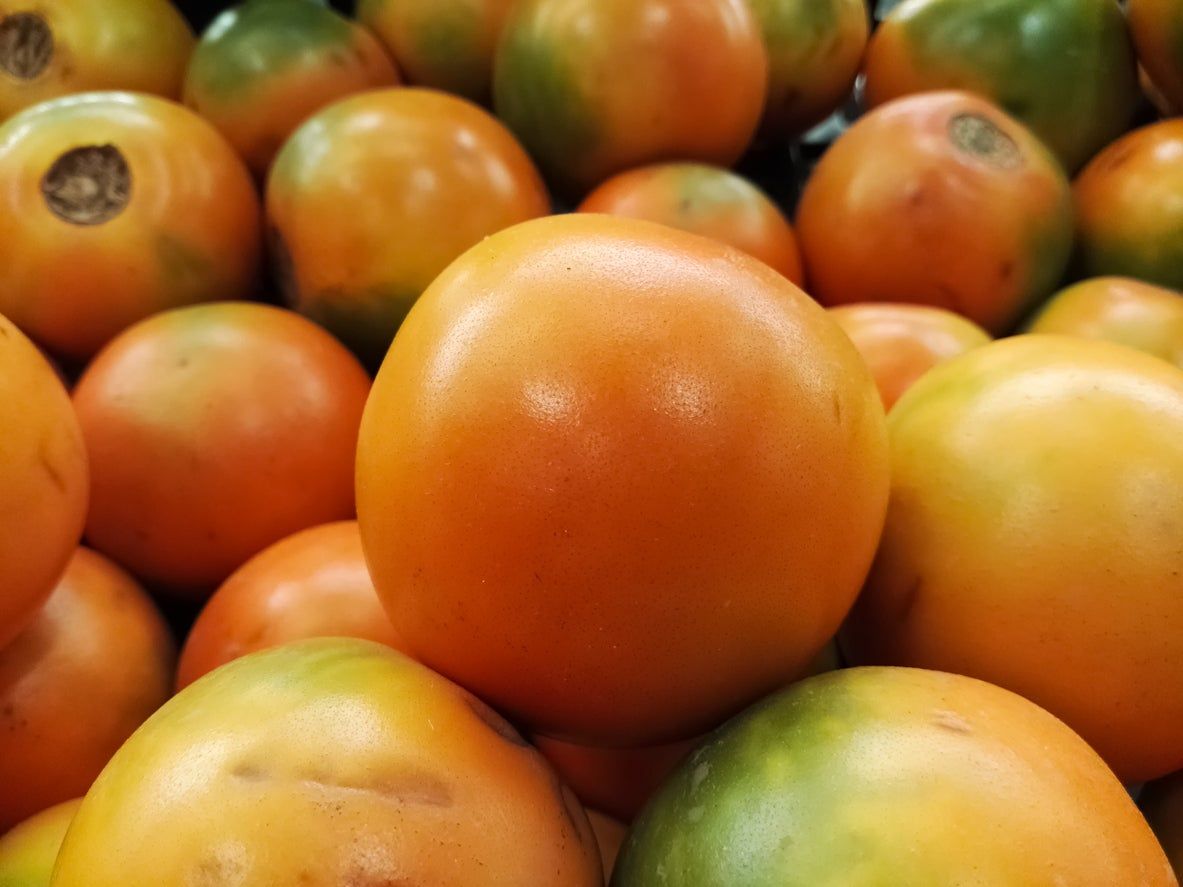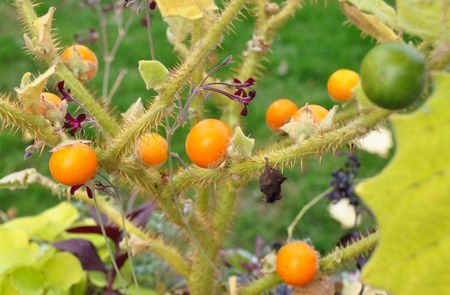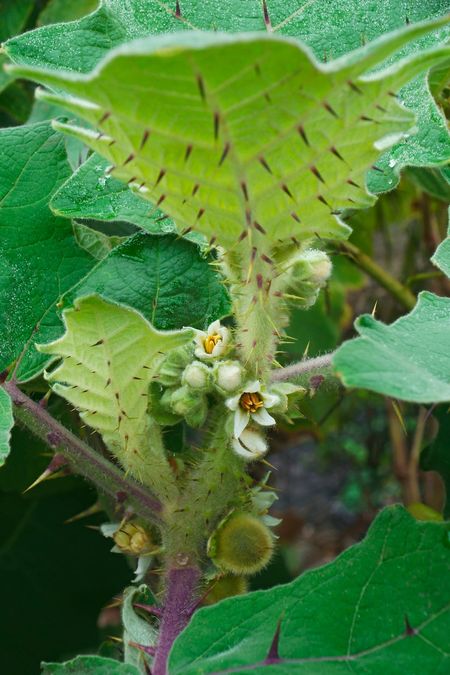Tips For Watering Naranjilla: How To Water A Naranjilla Tree


Naranjilla is a fun plant to grow if you have the right conditions and don’t have any small children or outdoor animals that could be harmed by its massive and numerous spines. This subtropical shrub native to South America produces edible fruits and provides unique visual interest. Know how to water this plant so you can keep it healthy and happy for its life span in your garden.
Naranjilla Water Requirements
Naranjilla has moderate water requirements, and it really needs to have well-drained soil. It will not tolerate or grow well with standing water or soggy roots. Before you put it in your garden, consider naranjilla irrigation, how you’ll water it, and be sure that the soil will drain adequately.
The naranjilla shrub, or small tree, is a subtropical plant that produces an orange fruit. You can harvest the fruit, if you can get around the terrifying spines, and use it to make juice. The pulpy interior of the fruit is also great for preserves. Even if you don’t use the fruit, this plant makes a fun addition to a garden in warm climates. It will not tolerate frost, although in colder areas it can be an annual.
This is a plant that grows quickly, several feet (1 m.) in the first year, and that means it needs regular watering. Its water requirements will go up in dry periods. Although it does tolerate drought fairly well, naranjilla will grow much better if you water it through those dry phases.
When and How to Water a Naranjilla
The best way to know when to water naranjilla is to look at the soil. While it does need regular watering, you should allow the soil to dry in between. Check on the soil, and if the surface is dry, it’s time to water. When watering naranjilla, it’s best to do it in the morning. This minimizes the risk of standing water overnight that encourages disease.
You can use drip irrigation for watering naranjilla to conserve water, but it isn’t necessary. If your climate is particularly dry, this can also help give the plant a more continuous flow of water without overwatering. You can also use mulch to help hold water in if your climate is dry.
Perhaps most importantly of all, avoid overwatering naranjilla. Few plants can tolerate soggy roots, but naranjilla is particularly susceptible to damage caused by overwatering. Always watch the soil and water only when the surface has dried.
Gardening tips, videos, info and more delivered right to your inbox!
Sign up for the Gardening Know How newsletter today and receive a free copy of our e-book "How to Grow Delicious Tomatoes".

Mary Ellen Ellis has been gardening for over 20 years. With degrees in Chemistry and Biology, Mary Ellen's specialties are flowers, native plants, and herbs.
-
 5 Fabulous Fast-Growing Vines – That Will Quickly Climb Any Arbor, Trellis, Or Fence
5 Fabulous Fast-Growing Vines – That Will Quickly Climb Any Arbor, Trellis, Or FenceThese fast growing vines are perfect for covering any eyesores in your yard or creating a living fence. They will provide great visual interest, as well.
By Amy Grant
-
 Best Indeterminate Tomatoes: Flavor-Packed Varieties For Fresh Harvests All Summer Long
Best Indeterminate Tomatoes: Flavor-Packed Varieties For Fresh Harvests All Summer LongIndeterminate tomatoes are vining varieties that fruit all season. Discover their distinctive features and how to choose the best type to grow in your garden.
By Bonnie L. Grant
-
 Naranjilla Pest Problems: What Are Common Naranjilla Pests
Naranjilla Pest Problems: What Are Common Naranjilla PestsThe naranjilla plant is a tough little tree, but it occasionally gets attacked by naranjilla pests, notably the root knot nematode. For information about naranjilla pest problems, including a list of bugs that eat naranjilla, this article can help.
By Teo Spengler
-
 Naranjilla Propagation: Tips For Growing New Naranjilla Trees
Naranjilla Propagation: Tips For Growing New Naranjilla TreesA common name of “little orange” might lead one to think naranjilla is a citrus, but it is not. However, the taste is similar to a tart pineapple or lemon. If you want to grow this unusual specimen or have one and wish for more, learn how to propagate naranjilla here.
By Becca Badgett
-
 Picking Naranjilla Fruits: Tips For Harvesting Naranjilla
Picking Naranjilla Fruits: Tips For Harvesting NaranjillaNaranjilla fruit tends to be flavorless and unpleasant when unripe. However, it can be tangy and delicious if naranjilla harvest occurs at the optimum point of ripeness. So, how to you know when to harvest naranjilla? Learn more about harvesting this interesting fruit here.
By Mary H. Dyer
-
 Naranjilla Seed Propagation – Learn How To Grow Naranjilla From Seed
Naranjilla Seed Propagation – Learn How To Grow Naranjilla From SeedIt’s a lot of fun to bring naranjilla into your garden, and inexpensive too, since you can easily grow naranjilla from seed. Click this article for information about naranjilla seed germination as well as tips for propagating naranjilla seeds.
By Teo Spengler
-
 Naranjilla Layering Info: Learn How To Layer Naranjilla Trees
Naranjilla Layering Info: Learn How To Layer Naranjilla TreesInterested in learning how to layer naranjilla? Air layering, which involves rooting a naranjilla branch while it’s still attached to the parent plant, is surprisingly easy. Click on the following article to learn about naranjilla air layering propagation.
By Mary H. Dyer
-
 Growing Naranjilla From Cuttings – How To Root Naranjilla Cuttings
Growing Naranjilla From Cuttings – How To Root Naranjilla CuttingsCan you grow naranjilla from cuttings? Yes, you sure can, and it’s not all that difficult. Click on the following article to learn about naranjilla cutting propagation and growing naranjilla from cuttings.
By Mary H. Dyer
-
 Eating Naranjilla – Learn How To Use Naranjilla Fruit
Eating Naranjilla – Learn How To Use Naranjilla FruitNaranjilla is indigenous to Colombia, Ecuador, Peru and Venezuela. If visiting these countries, it is highly recommended that you try eating it. Each culture has a different way of using naranjilla fruit; all are delicious. How do the locals use naranjilla? Find out here.
By Amy Grant
-
 Kinds Of Naranjilla Fruit: Are There Different Varieties Of Naranjilla
Kinds Of Naranjilla Fruit: Are There Different Varieties Of NaranjillaThere are three naranjilla varieties: spineless types of naranjilla cultivated in Ecuador, spined varieties of naranjilla grown primarily in Colombia and another type called baquicha. The following article discusses the three different naranjilla varieties.
By Amy Grant